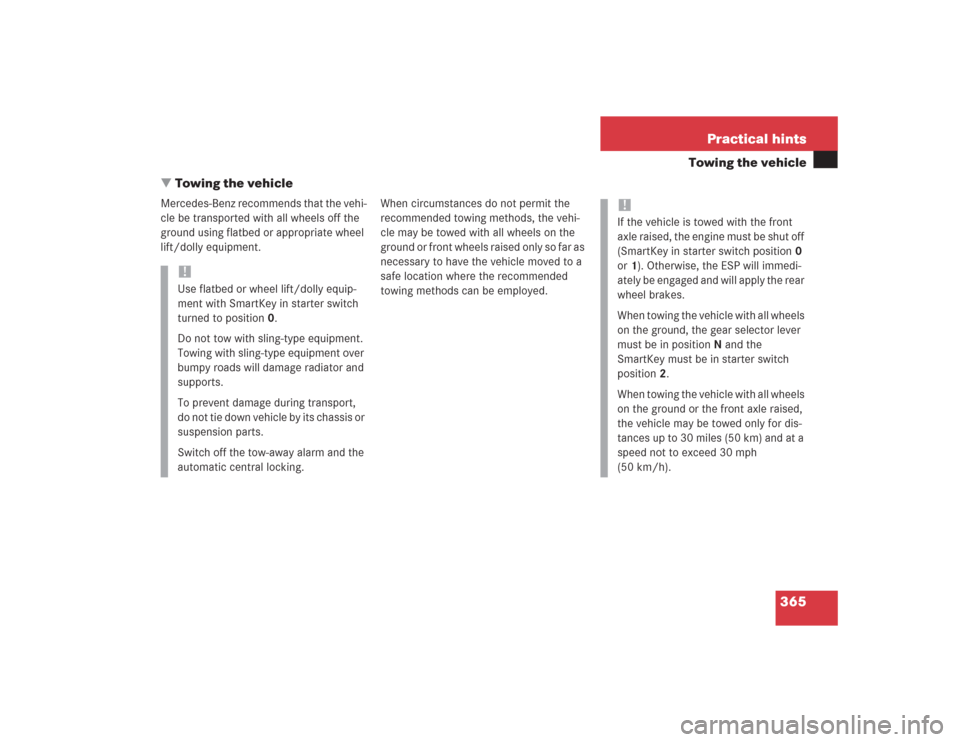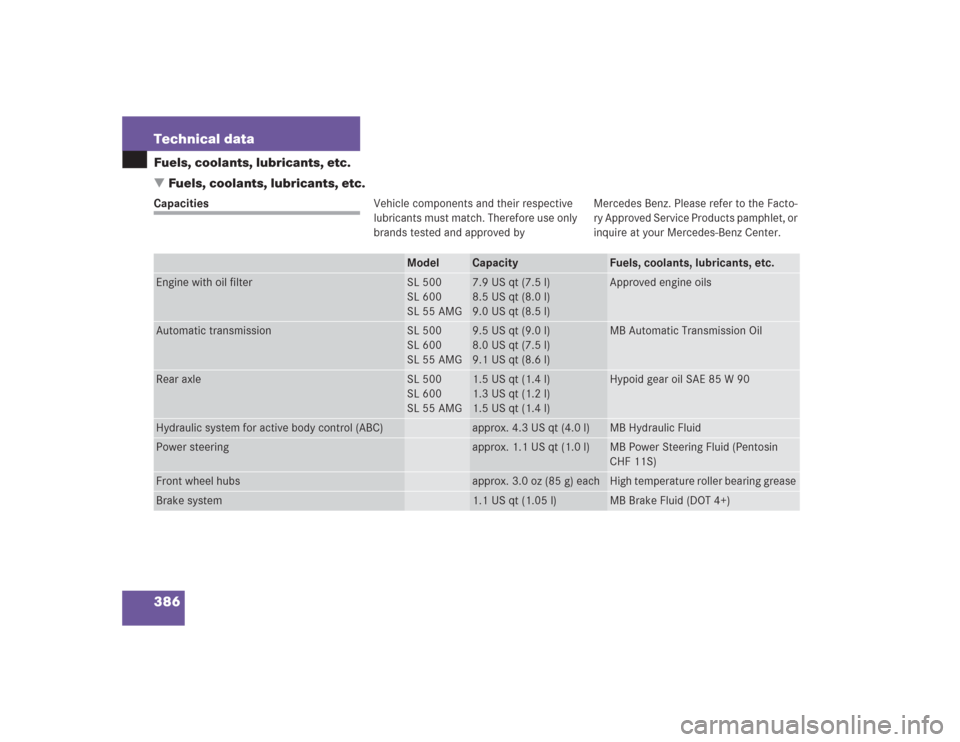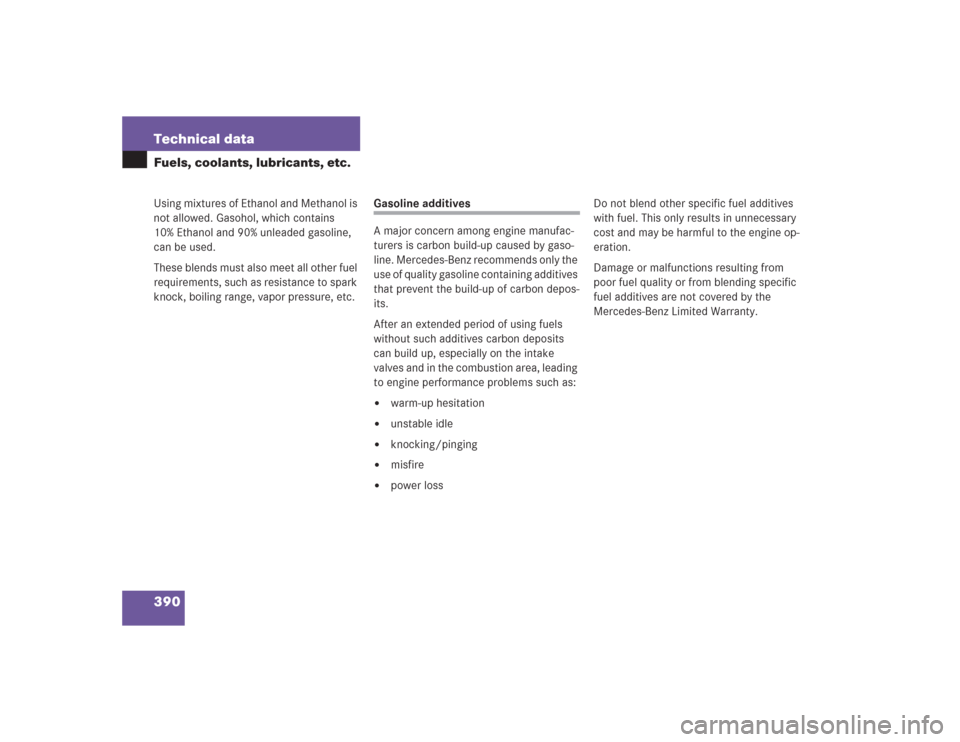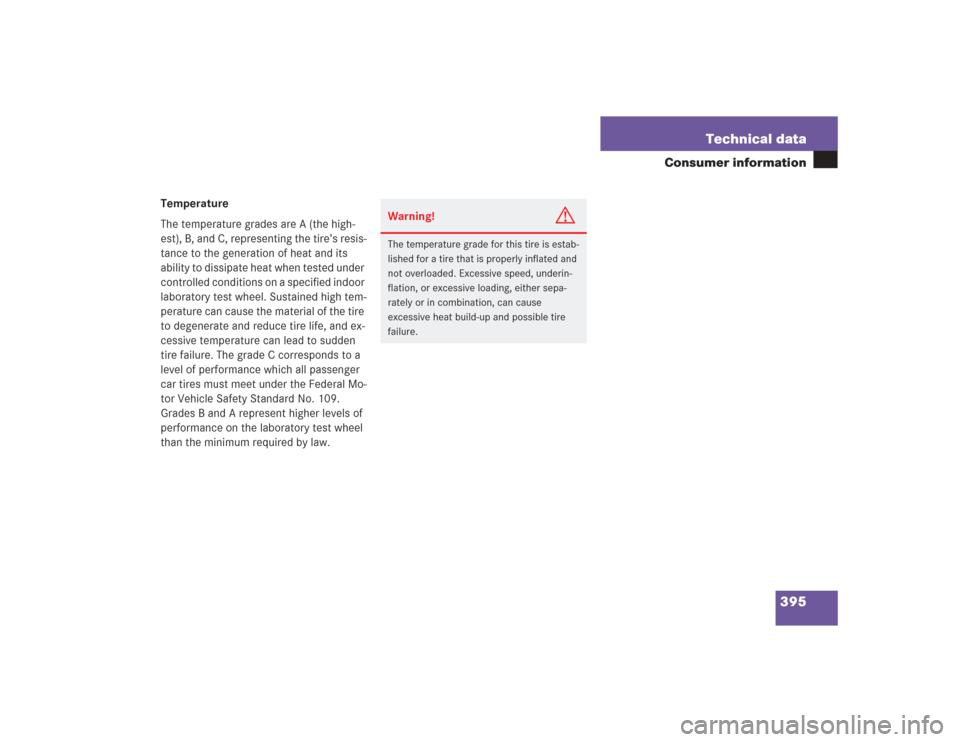Page 363 of 434
362 Practical hintsBatteriesReconnecting the battery for electrical
consumers�
Turn off all electrical consumers.
�
Connect the positive lead and fasten its
cover.
�
Connect the negative lead.
�
Reinstall the trunk floor.
�
Rehook trunk luggage cover into hold-
ers.
!Never invert the terminal connections!iThe following procedures must be car-
ried out following any interruption of
battery power (e.g. due to reconnec-
tion):�
Resynchronize the ESP
(�page 295).
�
Resynchronize side windows
(�page 183).
Page 366 of 434

365 Practical hints
Towing the vehicle
�Towing the vehicle
Mercedes-Benz recommends that the vehi-
cle be transported with all wheels off the
ground using flatbed or appropriate wheel
lift/dolly equipment.When circumstances do not permit the
recommended towing methods, the vehi-
cle may be towed with all wheels on the
ground or front wheels raised only so far as
necessary to have the vehicle moved to a
safe location where the recommended
towing methods can be employed.
!Use flatbed or wheel lift/dolly equip-
ment with SmartKey in starter switch
turned to position0.
Do not tow with sling-type equipment.
Towing with sling-type equipment over
bumpy roads will damage radiator and
supports.
To prevent damage during transport,
do not tie down vehicle by its chassis or
suspension parts.
Switch off the tow-away alarm and the
automatic central locking.
!If the vehicle is towed with the front
axle raised, the engine must be shut off
(SmartKey in starter switch position0
or1). Otherwise, the ESP will immedi-
ately be engaged and will apply the rear
wheel brakes.
When towing the vehicle with all wheels
on the ground, the gear selector lever
must be in positionN and the
SmartKey must be in starter switch
position2.
When towing the vehicle with all wheels
on the ground or the front axle raised,
the vehicle may be towed only for dis-
tances up to 30 miles (50 km) and at a
speed not to exceed 30 mph
(50 km/h).
Page 377 of 434
376 Technical dataEngine
�EngineModel
SL 500 (230.475)
1
SL 600 (230.476)
1
Engine
113
275
Mode of operation
4-stroke engine, gasoline injection
4-stroke engine, gasoline injection
No. of cylinders
8
12
Bore
3.82 in (97.00 mm)
3.23 in (82.00 mm)
Stroke
3.31 in (84.00 mm)
3.43 in (87.00 mm)
Total piston displacement
303.0 cu in (4966 cm
3)
336.4 cu in (5 513 cm
3)
Compression ratio
10:1
9:1
Output acc. to SAE J 1349
302 hp / 5 600 rpm
2
(225 kW / 5 600 rpm)
493 hp /5 000 rpm
2
(368 kW / 5 000 rpm)
Maximum torque acc. to SAE J 1349
339 lb-ft / 2 700 rpm
(460 Nm / 2700 rpm)
590 lb-ft /3 500 rpm
(800 Nm /3 500 rpm)
Maximum engine speed
6000 rpm
5750 rpm
Firing order
1-5-4-2-6-3-7-8
1-12-5-8-3-10-6-7-2-11-4-9
Poly-V-belt
2390 mm
2335 mm
1The quoted data apply only to the standard vehicle. See an authorized Mercedes-Benz Center for the corresponding data of all special bodies and special equipment.2Premium fuel required. Performance may vary with fuel octane rating.
Page 387 of 434

386 Technical dataFuels, coolants, lubricants, etc.
�Fuels, coolants, lubricants, etc.CapacitiesVehicle components and their respective
lubricants must match. Therefore use only
brands tested and approved by Mercedes Benz. Please refer to the Facto-
ry Approved Service Products pamphlet, or
inquire at your Mercedes-Benz Center.
Model
Capacity
Fuels, coolants, lubricants, etc.
Engine with oil filter
SL 500
SL 600
SL 55 AMG
7.9 US qt (7.5 l)
8.5 US qt (8.0 l)
9.0 US qt (8.5 l)
Approved engine oils
Automatic transmission
SL 500
SL 600
SL 55 AMG
9.5 US qt (9.0 l)
8.0 US qt (7.5 l)
9.1 US qt (8.6 l)
MB Automatic Transmission Oil
Rear axle
SL 500
SL 600
SL 55 AMG
1.5 US qt (1.4 l)
1.3 US qt (1.2 l)
1.5 US qt (1.4 l)
Hypoid gear oil SAE 85 W 90
Hydraulic system for active body control (ABC)
approx. 4.3 US qt (4.0 l)
MB Hydraulic Fluid
Power steering
approx. 1.1 US qt (1.0 l)
MB Power Steering Fluid (Pentosin
CHF 11S)
Front wheel hubs
approx. 3.0 oz (85 g) each
High temperature roller bearing grease
Brake system
1.1 US qt (1.05 l)
MB Brake Fluid (DOT 4+)
Page 391 of 434

390 Technical dataFuels, coolants, lubricants, etc.Using mixtures of Ethanol and Methanol is
not allowed. Gasohol, which contains
10% Ethanol and 90% unleaded gasoline,
can be used.
These blends must also meet all other fuel
requirements, such as resistance to spark
knock, boiling range, vapor pressure, etc.
Gasoline additives
A major concern among engine manufac-
turers is carbon build-up caused by gaso-
line. Mercedes-Benz recommends only the
use of quality gasoline containing additives
that prevent the build-up of carbon depos-
its.
After an extended period of using fuels
without such additives carbon deposits
can build up, especially on the intake
valves and in the combustion area, leading
to engine performance problems such as:�
warm-up hesitation
�
unstable idle
�
knocking/pinging
�
misfire
�
power lossDo not blend other specific fuel additives
with fuel. This only results in unnecessary
cost and may be harmful to the engine op-
eration.
Damage or malfunctions resulting from
poor fuel quality or from blending specific
fuel additives are not covered by the
Mercedes-Benz Limited Warranty.
Page 396 of 434

395 Technical data
Consumer information
Temperature
The temperature grades are A (the high-
est), B, and C, representing the tire’s resis-
tance to the generation of heat and its
ability to dissipate heat when tested under
controlled conditions on a specified indoor
laboratory test wheel. Sustained high tem-
perature can cause the material of the tire
to degenerate and reduce tire life, and ex-
cessive temperature can lead to sudden
tire failure. The grade C corresponds to a
level of performance which all passenger
car tires must meet under the Federal Mo-
tor Vehicle Safety Standard No. 109.
Grades B and A represent higher levels of
performance on the laboratory test wheel
than the minimum required by law.
Warning!
G
The temperature grade for this tire is estab-
lished for a tire that is properly inflated and
not overloaded. Excessive speed, underin-
flation, or excessive loading, either sepa-
rately or in combination, can cause
excessive heat build-up and possible tire
failure.
Page 398 of 434

397 Technical terms
ABS
(A
ntilock B
rake S
ystem)
Prevents the wheels from locking up
during braking so that the vehicle can
continue to be steered.
ABC
(A
ctive B
ody C
ontrol)
Active, computer-controlled system
that hydraulically adjusts the suspen-
sion at all four wheels in response to
various driving situations.
Alignment bolt
Metal pin with thread. The alignment
bolt, or centering bolt, is an aid used
when changing a tire to align the wheel
with the wheel hub.BabySmart
TM1
airbag deactivation
system
This system detects if a special system
compatible child restraint seat is in-
stalled on the front passenger seat. The
system will automatically deactivate
the passenger front airbag when such a
seat is properly installed (indicator
lamp 7 on the glove box comes on).
See your authorized Mercedes-Benz
Center for availability.
BabySmart
TM compatible child seats
Special restraint system for children.
The sensor system for the passenger
seat prevents deployment of the pas-
senger front airbag if a BabySmart
TM
compatible child seat is installed.BAS
(B
rake A
ssist S
ystem)
System for potentially reducing braking
distances in emergency braking situa-
tions. The system is activated when it
senses an emergency based on how
fast the brake is applied.
Bi-Xenon headlamps*
Headlamps which use an electric arc as
the light source and produce a more in-
tense light than filament headlamps.
Bi-Xenon headlamps produce low
beam and high beam.
CAC
(C
ustomer A
ssistance C
enter)
Mercedes-Benz customer service cen-
ter, which can help you with any ques-
tions about your vehicle and provide
assistance in the event of a break-
down.
1BabySmart
TM
is a trademark of Siemens
Automotive Corp.
Page 399 of 434

398 Technical termsCAN system
(C
ontroller A
rea N
etwork)
Data bus network serving to control ve-
hicle functions such as door locking or
windshield wiping depending on vehi-
cle settings and/or ambient condi-
tions.
Cockpit
All instruments, switches, buttons and
indicator/warning lamps in the passen-
ger compartment needed for vehicle
operation and monitoring.
Collapsible tire
An especially compact spare tire that
must be inflated with a provided air
pump before using. It should only be
used to bring the vehicle to the nearest
service station.
COMAND
(Co
ckpit Man
agement and
D
ata System)
Information and operating center for
vehicle sound and communications
systems, including the radio, CD changer and navigation system, as well
as other optional equipment (e.g. tele-
phone).
Control system
The control system is used to call up
vehicle information and to change
component settings. Information and
messages appear in the multifunction
display. The driver uses the buttons on
the multifunction steering wheel to
navigate through the system and to ad-
just settings.
Cruise control
Driving convenience system for auto-
matically maintaining the vehicle speed
set by the driver.
Distronic*
A driving convenience cruise control
system which helps the driver maintain
a pre-selected speed:
�
If there is no vehicle directly ahead,
the system operates in the same
way as conventional cruise control.
�
If a slower moving vehicle is ahead,
Distronic* will reduce your vehicle
speed to the extent permitted by re-
duced throttle and up to 20% brak-
ing power to maintain the preset
minimum following distance.
DTR
(->Distr
onic*)
Engine number
The number set by the manufacturer
and placed on the cylinder block to
uniquely identify each engine pro-
duced.
ESP
(E
lectronic S
tability P
rogram)
Improves vehicle handling and direc-
tional stability.
ETD
(E
mergency Tensioning D
evice)
Device which deploys in certain frontal
and rear collisions exceeding the sys-
tem's threshold to tighten the seat
belts.
->SRS